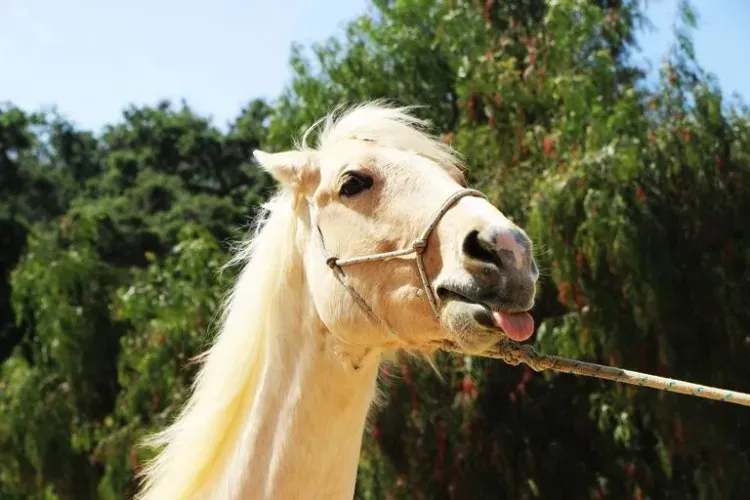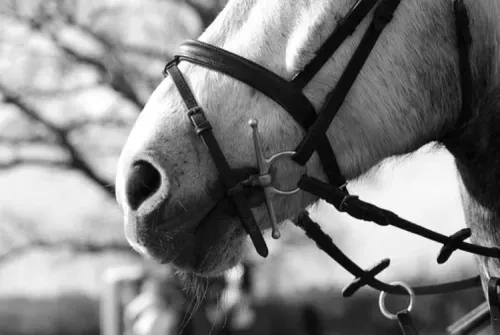
Horses that are sensitive to handling around the head are called Head Shy. If the problem is only associated with being bridled they are called Bridle Shy and this is generally associated with a fear of the bridle going over the ears. In order to help head/bridle shy horses, we must know the cause of their presenting anxieties.
With Head and Bridle Shy Horses there are 3 Causes
- Poor handling techniques leading to pain
- Pain caused through injury or disease but not related to training
- General anxiety
These causes can be linked. For example, the horse ridden in a bit that is too narrow and pinches could develop anxieties because he anticipates discomfort. This means that once an underlying cause is removed the horse will still have a memory of pain and associate the bit with poor experiences. Some horses are more sensitive and these are more likely to have head/bridle shy problems. Now we need to consider the three causes in greater depth.
Poor Handling Techniques leading to Pain
Here are typical problems:
- A rider with rough and insensative hands
- Roughness when offering the bit to the horses mouth
- A bit that is too narrow and pinches the corners of the lips
- Having the bit too high and creating a constant pressure on the mouth bars and at the poll
- Forcing a horse to work in an overbent outline
- Rough handling around the horses head and in particular around his ears
- Training injurys, causing pain, particularly in the shoulder and neck
Remember, if a horse associates the bridle with pain he is going to be unhappy.
Pain caused through Injury or Disease but not linked to Training
There are many problems to be ruled out but look for any of the following:
- Wolf teeth
- Tooth absess
- Sharpe teeth
- Ear infection
- Ear mites
- Nasal infection
- Cranial disorder
- Gutteral pouch
- Other
These problems must be ruled out in order to help the head/bridle shy horse.
General Anxiety
Assuming human interactions, injury or disease are not responsible, the head shy horse is anxious by nature and not accustomed to human interference. Some horses will have anxiety with your hands around their face and others will only have anxiety when their ears are touched.
How to Help the Head/Bridle Shy Horse
Physical and training problems have been ruled out or rectified so the horse is now ready to be helped. At this point remember two things:
- Horses respond to the release of pressure
- They also respond to rewards for positive behaviour.
The Release of Pressure
This is best explained using two examples.
Example 1
A head-shy horse throws his head up when his human approaches and the human backs off. This teaches the horse that the pressure is turned off when he throws his head. He avoids human contact and received a positive reward for this behaviour.
Example 2
Another head-shy horse throws his head up when his human safely approaches from the side but the human remains quiet and does not back off until the horse stops throwing his head. This teaches the horse that pressure is turned off when he stops being head-shy and the positive reward is created by the release of pressure.
Start with very Small Steps
When the horse shows even the smallest release from being head shy is the moment to back off. This process must be routinely and daily carried out. Eventually, the horse will let the human stand quietly by his head and realises there is no problem. Now we need to consider things in more depth.
3 Steps to Re-programming the Head Shy Horse
1. Finger Flicks
Stand to the side of your horse so you will be safe from his teeth and hooves. Have a lead rope attached to his head collar but hold this loosely. Raise your other hand and rhythmically flick your fingers back and forth as if you are flicking water at the horse. Do this just within the horse’s personal space but not touching him and remain calm. The horse will raise his head and may try to move back. Calmly keep with him while continuing with the rhythmical flick movements.
Be very observant and the first time your horse slightly relaxes, stop flicking. Praise with your voice and pat him somewhere away from his face. It is very important to stop flicking when the horse slightly relaxes but you must not stop until this happens. Repeat this process a few times and then do the same process on the other side of his head.
Repeat this routine daily and when your horse is happy with finger flicks progress to a palm thrust. Again you must not make any contact with the horse as this will reinforce his fear. Remember, stop and praise when the horse shows some acceptance of what you are doing.
2. Palm Push
Again stand to the side of your horse so you will be safe from his teeth and hooves. Have a lead rope attached to his head collar but hold this loosely. A palm push is rhythmically and slowly moving the palm of your hand back and forth towards the horse’s head. You must not touch the head with your palm. As before repeating this daily on both sides of your horse’s head until he is not stressed with palm thrusts. Remember that every time he relaxes reward as with the finger flick technique.
3. Robot Arms
This is the final stage and your horse must be showing no reaction to finger flicks and palm pushes before attempting this.
For robot arms drop the lead rope and stand in front of your horse. Alternatively lower and raise your outstretched arms in a calm and rhythmical way. As soon as the horse is relaxed, stop and reward him as with the previous two activities. Again repeat this daily until the horse has no fear.
These techniques will desensitise your horse to humans in his personal space.
Re-programming the Bridle Shy Horse
Generally, these horses are worried about their ears being touched. However, make sure the horse has no problem with humans touching his head. If required, use the 3 steps to re-programming a head shy horse. Once the horse is desensitised to humans in his personal space you can work on the bridle shy issue.
Make this tool
Tie a small soft rag to the end of a foot-long stick.
Use this Strategy
- Put on your horses head collar with out touching his ears
- Stand next to his head with a loose lead rope
- Approach the left ear with the stick. Go slowly and keep with the horse if he backs off but make contact with the ear
- Repeat this process until the horse shows a sign of relaxing
- Then stop and reward with your voice and patting
- Repeat daily on both sides of the head until the horse accepts his ears being touched.

Article Suggestion
Danger and Discomfort with Synthetic Tack
